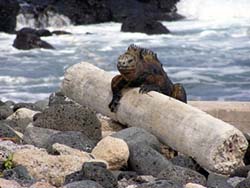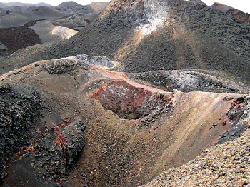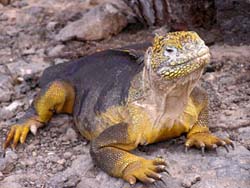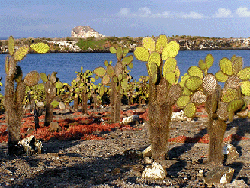The Galápagos Islands
 The
Galápagos Islands are straddling the equator some 600 miles
(1000km) from the South American continent. Sitting on top of a
volcanic hotspot these islands developed without ever having had a
connection to the continent. Only few terrestrial animals could arrive
on this isolated place. They stranded by chance, clinging on drift wood
of floating plants. Those that survived the long journey found a place
with a harsh climate, void of fresh water and poor in food.
The
Galápagos Islands are straddling the equator some 600 miles
(1000km) from the South American continent. Sitting on top of a
volcanic hotspot these islands developed without ever having had a
connection to the continent. Only few terrestrial animals could arrive
on this isolated place. They stranded by chance, clinging on drift wood
of floating plants. Those that survived the long journey found a place
with a harsh climate, void of fresh water and poor in food. Extreme specializations were a necessity
for the newcomers to prevail. Exchange between the islands
was limited and different forms of life could evolve from common
ancestors due to genetic drift, strong selection pressures, and
reproductive isolation. A famous example for this adaptive radiation is
the group of 12 Darwin Finches. Rosemarie and Peter Grant at Princeton
University studied their evolutionary ecology for over 30 years and
published their results in numerous contributions.
Extreme specializations were a necessity
for the newcomers to prevail. Exchange between the islands
was limited and different forms of life could evolve from common
ancestors due to genetic drift, strong selection pressures, and
reproductive isolation. A famous example for this adaptive radiation is
the group of 12 Darwin Finches. Rosemarie and Peter Grant at Princeton
University studied their evolutionary ecology for over 30 years and
published their results in numerous contributions. Not only the establishment of stranded animals and
plants was challenged by the harsh climate and lack of fresh water - it
also prevented early human colonization. The first sailors called this
barren land "Las Islas Encantadas" - the enchanted islands. Their
aversion and the corresponding delay of colonization was a blessing for
wildlife and plants and prevented the huge loss of biodiversity that
struck most other archipelagos after the arrival of man.  Usually island environments are suffering already many
centuries from introduced species and novel predators, such as cats,
dogs pigs, goats, rats, birds, as
well as many arthropods as stowaways, which came along with human
colonizers. The ensuing predation and
competition were responsible for major extinctions that hit most of the
islands, a prime example being the Hawaii archipelago. In contrast, Galápagos was spared this fate for a
long time. Therefore,
the archipelago is still blessed with a wealth of endemic
lifeforms, those which exist only on the Galápagos. Therefore,
the Galápagos archipelago is being called a last paradise by
those who appriciate its biological treasures.
Usually island environments are suffering already many
centuries from introduced species and novel predators, such as cats,
dogs pigs, goats, rats, birds, as
well as many arthropods as stowaways, which came along with human
colonizers. The ensuing predation and
competition were responsible for major extinctions that hit most of the
islands, a prime example being the Hawaii archipelago. In contrast, Galápagos was spared this fate for a
long time. Therefore,
the archipelago is still blessed with a wealth of endemic
lifeforms, those which exist only on the Galápagos. Therefore,
the Galápagos archipelago is being called a last paradise by
those who appriciate its biological treasures. 
 Usually island environments are suffering already many
centuries from introduced species and novel predators, such as cats,
dogs pigs, goats, rats, birds, as
well as many arthropods as stowaways, which came along with human
colonizers. The ensuing predation and
competition were responsible for major extinctions that hit most of the
islands, a prime example being the Hawaii archipelago. In contrast, Galápagos was spared this fate for a
long time. Therefore,
the archipelago is still blessed with a wealth of endemic
lifeforms, those which exist only on the Galápagos. Therefore,
the Galápagos archipelago is being called a last paradise by
those who appriciate its biological treasures.
Usually island environments are suffering already many
centuries from introduced species and novel predators, such as cats,
dogs pigs, goats, rats, birds, as
well as many arthropods as stowaways, which came along with human
colonizers. The ensuing predation and
competition were responsible for major extinctions that hit most of the
islands, a prime example being the Hawaii archipelago. In contrast, Galápagos was spared this fate for a
long time. Therefore,
the archipelago is still blessed with a wealth of endemic
lifeforms, those which exist only on the Galápagos. Therefore,
the Galápagos archipelago is being called a last paradise by
those who appriciate its biological treasures. 
The
first colonizers of the Galápagos Islands were a few scattered
European settlers at the end of the 19th and the first half of the 20th
century. Slowly the local population increased on four of the major
islands. At the same time, the international community identified areas
of prime interest for conservation within the archipelago. The Charles Darwin
Foundation and the National Park Service were established in 1959.
During the end of the 20th century, fishing became a lucrative business
for local Galapagenos, and the tourism boomed. The increasing living
standard attracted more and more immigrants from the continent. Today,
roughly which live on 4% of the land. The remainder area is set aside
as protected National Park area. Population growth is around 3% and
many tourists arriving at the Galapagos are surprised to find a town at
Puerto Ayora, St. Cruz, where they did expect nothing but nature and
solitude.  The growing population,
overexplotation of marine resources, arbitrary and involuntary
introduction of foreign plant and animals species, waste and pollution
all have become issues of great concern - threats which had been unkown
for so long in this remote part of the world. Recently,
several conflicts between lobbyists of the fishing sector and
conservationists reminded us that imminent decisions will have to be
taken in order to safeguard the unique biodiversity of this place.
The growing population,
overexplotation of marine resources, arbitrary and involuntary
introduction of foreign plant and animals species, waste and pollution
all have become issues of great concern - threats which had been unkown
for so long in this remote part of the world. Recently,
several conflicts between lobbyists of the fishing sector and
conservationists reminded us that imminent decisions will have to be
taken in order to safeguard the unique biodiversity of this place. 
 The growing population,
overexplotation of marine resources, arbitrary and involuntary
introduction of foreign plant and animals species, waste and pollution
all have become issues of great concern - threats which had been unkown
for so long in this remote part of the world. Recently,
several conflicts between lobbyists of the fishing sector and
conservationists reminded us that imminent decisions will have to be
taken in order to safeguard the unique biodiversity of this place.
The growing population,
overexplotation of marine resources, arbitrary and involuntary
introduction of foreign plant and animals species, waste and pollution
all have become issues of great concern - threats which had been unkown
for so long in this remote part of the world. Recently,
several conflicts between lobbyists of the fishing sector and
conservationists reminded us that imminent decisions will have to be
taken in order to safeguard the unique biodiversity of this place. 